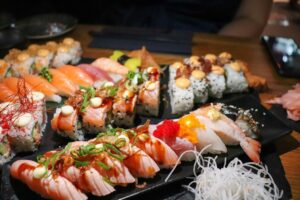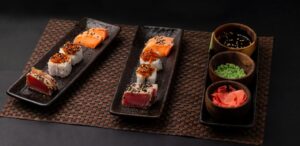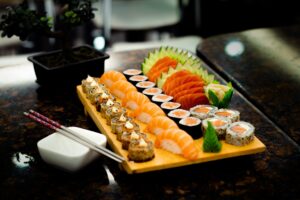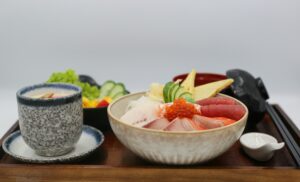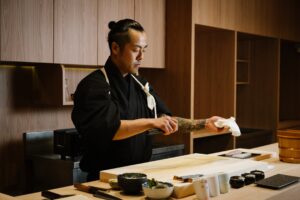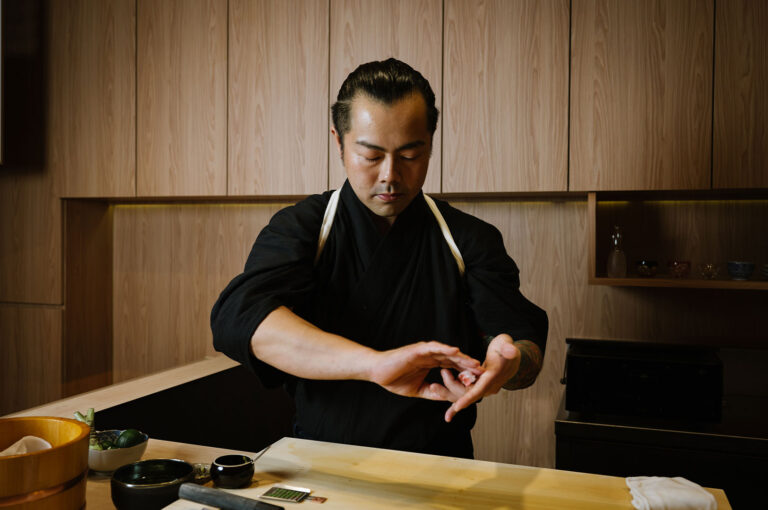
Best Food in Singapore: A Japanese Chef’s Guide to the Lion City’s Culinary Paradise
When most people hear “Japanese sushi,” they immediately think of raw fish. However, this beloved culinary art form is fundamentally about perfectly seasoned vinegared rice combined with the finest ingredients Japan has to offer. True Japanese sushi embodies centuries of culinary refinement, cultural tradition, and an unwavering commitment to perfection that defines Japanese cuisine.
From its humble origins as a preservation method to its current status as one of the world’s most revered culinary arts, sushi continues to captivate food enthusiasts across many countries. Whether you’re a longtime sushi lover or just beginning to explore this fascinating world, understanding the depth and artistry behind authentic Japanese sushi will transform how you experience every bite.
What is Japanese Sushi?
The word “sushi” derives from “su” (vinegar) and “meshi” (rice), revealing the dish’s true foundation: specially prepared rice seasoned with vinegar, sugar, and salt. This vinegared rice serves as the canvas for an array of fresh ingredients, including raw fish, cooked seafood, vegetables, and egg.
Sushi can also include other ingredients such as vegetables and unique regional specialties, allowing for a wide range of flavors and textures. There are various kinds of sushi, such as nigiri, gunkan, maki, temaki, oshizushi, inari, and chirashi, each with their own specific ingredients and preparation methods, reflecting the versatility and diversity of this cuisine. The common misconception that sushi simply means “raw fish” overlooks the intricate craftsmanship that transforms simple ingredients into edible art.

Traditional Japanese sushi represents the harmony of flavors, textures, and presentation that defines Japanese culinary philosophy. Each piece balances the subtle tang of seasoned rice with the pristine taste of fresh seafood, creating a symphony of flavors that changes with every variety.
In Japan, sushi holds deep cultural significance and is often reserved for special occasions. The preparation requires years of training, and master sushi chefs are regarded with the same respect as artists in other countries. This reverence extends beyond mere food preparation—it encompasses an entire philosophy of seasonality, respect for ingredients, and the pursuit of perfection in every detail.
At Sushi Masa by Ki-Setsu, we deeply resonate with the rich history and artistry of Japanese sushi described above. As part of the Kisetsu family, we are committed to honoring these time-honored traditions by meticulously sourcing the freshest seasonal ingredients and preparing each piece with the precision and respect it deserves. Our team embraces the philosophy of balance and harmony, ensuring that every bite reflects the perfect union of vinegared rice and premium seafood, just as authentic Japanese sushi has been crafted for centuries.

The Rich History and Evolution of Sushi
The journey of Japanese sushi began over a millennium ago with narezushi, a fermentation process used to preserve fish during the 8th century. Ancient practitioners packed fish with fermented rice and salt, creating a preservation method that could keep seafood edible for months. Interestingly, the fermented rice was typically discarded, while the preserved fish was consumed—quite different from modern sushi practices.
During the Muromachi period (1336-1573), Japanese palates began to evolve, and people started eating the vinegared rice alongside the fish. This marked a crucial transition from purely functional food preservation to the beginnings of culinary artistry. The rice was no longer merely a preservation medium but became an integral component of the dish itself.
The revolutionary moment in sushi history occurred in 1824 when Hanaya Yohei created Edomae sushi in Tokyo (then called Edo). His innovation involved using fresh fish from Tokyo Bay and serving it immediately over vinegared rice, eliminating the lengthy fermentation process. This breakthrough transformed sushi from a preserved food into the fresh, immediate culinary experience we recognize today. This development led to the concept of fast sushi, or haya-zushi, which eliminated fermentation and made sushi a quick, convenient dish.
In the mid-20th century, the rise of conveyor belt sushi (kaitenzushi) restaurants further revolutionized the sushi experience. In these establishments, plates of sushi travel around the dining area on a conveyor belt, allowing customers to select dishes as they pass by. Each plate is typically a different color, indicating different price points. This system not only makes sushi more accessible and affordable but also adds an interactive and fun element to the dining experience.
Establishments like Sushi Masa continue to preserve these time-honored techniques while adapting to modern sourcing and safety standards. The commitment to authenticity requires sourcing the finest ingredients, maintaining traditional preparation methods, and upholding the cultural significance that makes each sushi experience memorable. These restaurants serve as living museums, where ancient techniques meet contemporary excellence.
Traditional Types of Japanese Sushi
Nigiri Sushi
Nigiri sushi represents the pinnacle of sushi craftsmanship, featuring hand-pressed vinegared rice topped with fresh fish, seafood, or tamago (sweet egg). The technique requires precise temperature control—the rice must be body temperature while the fish remains perfectly chilled. Master chefs spend years perfecting the gentle pressure needed to form the rice base without compressing it too firmly.

Popular nigiri varieties include tuna (maguro), with its varying grades from lean akami to the prized fatty tuna (otoro), salmon with its buttery texture, yellowtail (hamachi) prized for its clean flavor, and sea urchin (uni) for its creamy, oceanic essence. Each type of sushi requires different handling techniques and optimal serving temperatures to showcase its unique characteristics.
At Sushi Masa, our chef’s expertise is evident in achieving the perfect harmony between vinegared rice and neta (topping). We understand that too much rice can overshadow the delicate flavors of the fish, while too little fails to provide the ideal balance. For instance, our medium fatty tuna nigiri is crafted with a slightly larger rice base to complement its rich flavor, whereas delicate white fish nigiri features a minimal rice portion to highlight its subtle taste.
We take pride in aging select fish varieties to enhance their flavor and texture, a process that, combined with our precise knife skills and strict temperature control, elevates our nigiri sushi beyond simple food to edible art. This dedication reflects years of training and our deep cultural appreciation, ensuring every piece we serve embodies the tradition and refinement of authentic Japanese sushi.
Maki Sushi (Rolled Sushi)
Maki sushi, or rolled sushi, offers endless possibilities for creative expression while maintaining traditional foundations. Hosomaki features thin rolls with a single filling wrapped in nori seaweed, creating clean, precise bites that highlight individual ingredients.
This precision allows Chef Masa to use the simple roll as a benchmark for ingredient quality and perfect technique, a clear expression of his personal philosophy. Traditional hosomaki varieties include cucumber rolls for refreshing palate cleansers and tuna rolls that showcase the fish’s pure flavor, reflecting the exacting standards seen at Sushi Masa’s intimate counter.
Futomaki
Futomaki represents the more elaborate end of rolled sushi, with thick rolls containing multiple ingredients arranged for both flavor complexity and visual appeal. These colorful presentations often include tamago, shiitake mushrooms, cucumber, and various seafood, creating a complete meal in each bite. While the signature omakase journey at Sushi Masa focuses on pristine seasonal nigiri and delicate cooked courses, this type of elaborate roll embodies the same challenge of balancing flavors and textures while maintaining structural integrity—a hallmark of Chef Masa’s own meticulous approach to Japanese craftsmanship.
Temaki
Temaki, or hand-rolled sushi (hand roll), takes a more casual approach with cone-shaped nori wrapped around rice and fillings. This style allows for larger portions and more creative combinations, making it perfect for sharing and interactive dining experiences. The cone shape prevents the nori from becoming soggy while keeping ingredients secure.
Inside Out Rolls
Inside out rolls, where rice appears on the outside and nori within, represent modern innovations that maintain traditional flavor profiles while appealing to contemporary preferences. Even variations like the California roll, though not traditional, demonstrate sushi’s adaptability while respecting core preparation principles. We honor these diverse styles by combining traditional techniques with a passion for seasonal excellence.
Other Traditional Varieties
Chirashi, or scattered sushi, features assorted sashimi artfully arranged over a bed of seasoned sushi rice in a bowl, allowing diners to enjoy many different types of fresh fish in a single meal. This style showcases the chef’s selection of the day’s finest ingredients, with different colored fish creating a visually appealing edible garden.
Gunkan maki, meaning “battleship” sushi, consists of oval-shaped rice wrapped with nori, forming a vessel for delicate toppings like sea urchin, salmon roe, or chopped fish, expanding the variety of flavors and textures beyond traditional nigiri sushi.
Inari sushi offers a unique experience with sweetened seasoned rice stuffed into fried tofu pockets, providing a slightly sweet vegetarian option that complements sushi’s essential flavors.
Oshizushi, or pressed sushi, originates from the Kansai region and involves pressing ingredients and sushi rice in wooden molds to create dense, flavorful pieces with geometric shapes. This box sushi technique highlights traditional preservation methods and regional variations in sushi preparation across Japan, adding to the diverse world of traditional Japanese sushi enjoyed in sushi restaurants worldwide.

Premium Ingredients: The Foundation of Exceptional Sushi
Sushi Rice (Shari)
At Sushi Masa, we recognize that the foundation of exceptional sushi starts with specially prepared rice. We carefully select premium short-grain Japanese varieties like Koshihikari, prized for their ideal texture and starch content. Our rice preparation process is meticulous—balancing the washing to retain essential starches while avoiding excess stickiness, ensuring the perfect consistency.
We season the rice with a precise blend of rice vinegar, sugar, and salt to achieve a slightly sweet and tangy base that beautifully complements our fresh seafood without overpowering it. This seasoning is added while the rice is still warm and then cooled to body temperature through gentle fanning and folding, preserving the integrity of each grain.
Maintaining the right temperature is vital in our kitchen; rice that is too cold loses its texture, while rice that is too warm can affect the overall harmony of the sushi. To guarantee consistent quality throughout service, our chef prepares the rice multiple times daily, reflecting our commitment to excellence in every piece we serve.
The ideal texture we strive for allows the grains to hold together just enough to support the fish, yet dissolve gently on the palate—a balance that takes years of experience to master. This dedication to rice craftsmanship is at the heart of Sushi Masa’s pursuit of authentic Japanese sushi.
Tempura, another traditional Japanese dish, is often served alongside sushi to enhance the dining experience. Sake, a traditional Japanese rice wine, is also commonly enjoyed with sushi, further enriching the meal.
Fresh Seafood Selection
At Sushi Masa, we source our fresh fish daily from premium suppliers, including the renowned Toyosu Fish Market in Tokyo, ensuring that only the finest seafood reaches our sushi counter. We carefully assess quality indicators such as clear eyes, bright red gills, firm flesh, and a clean ocean scent, and any fish that does not meet our exacting standards is immediately set aside.
We embrace the changing seasons by tailoring our fish selection to highlight the best each period has to offer. In spring, we look forward to sea bream at its peak; summer brings sweet shrimp; autumn showcases prime mackerel sushi; and winter offers the richest fatty tuna. Our seasonal menu reflects this natural rhythm, allowing us to provide an optimal flavor experience that honors the bounty of each season.
Our chef also applies aging techniques to select white-meat fish like sea bream and flounder, carefully controlling the process to concentrate flavors and improve texture. This delicate balance requires expert knowledge to ensure the fish is matured just enough to enhance taste without compromising freshness or safety.
Understanding the nuances of fat content in fish such as tuna is essential to our craft. We recognize that the belly’s fatty tuna commands a premium for its buttery richness, and we thoughtfully recommend specific cuts to our guests, aligning with their preferences while maximizing the ingredient’s potential.
The Art of Sushi Preparation
Becoming a skilled sushi chef requires years of dedicated training, often beginning with basic tasks like rice preparation and counter cleaning before advancing to fish handling and knife work. Traditional apprenticeships can last up to a decade, with students gradually earning the right to handle increasingly expensive ingredients as their skills develop.
Knife skills form the cornerstone of sushi preparation, requiring specialized Japanese knives designed for specific tasks. The yanagiba knife, with its long, single-beveled blade, creates clean cuts through fish without tearing the flesh, while the deba knife handles fish butchering tasks. Maintaining these knives requires daily sharpening and proper storage to preserve their razor-sharp edges.
At Sushi Masa, we recognize that precise temperature control is vital not only for our specially prepared sushi rice but throughout the entire sushi-making process. Our chef carefully maintains the fish at optimal temperatures during preparation and service, while ensuring his hands stay warm enough to handle the rice gently, preserving its ideal texture. Even the wooden cutting boards we use are thoughtfully managed to maintain the freshness and quality of every ingredient.
Our philosophy of presentation centers on simplicity, seasonality, and harmony. Each piece we create is designed to highlight the natural beauty of its ingredients, with careful consideration of color, texture, and form to achieve a balanced and elegant visual appeal. This attention to detail transforms dining into a multisensory experience that delights sight, smell, taste, and texture alike.
Preparation at Sushi Masa begins well in advance of service, with our chef selecting the finest fish, preparing the rice with precision, and organizing ingredients for seamless efficiency. This disciplined process, refined through years of dedication, ensures consistent quality while allowing room for creativity when exceptional seasonal ingredients become available.
Proper Sushi Etiquette and Dining Experience
At the Sushi Counter
Engaging respectfully with the sushi chef creates a collaborative dining experience where expertise and appreciation combine to create memorable meals. Appropriate questions about fish origins, preparation methods, and recommendations demonstrate genuine interest while allowing chefs to share their knowledge and passion for their craft.

The best omakase experiences represent the ultimate trust between diner and chef, allowing skilled professionals to showcase their expertise through carefully selected ingredients and optimal preparation timing. This collaborative approach often reveals fish varieties and preparations that diners might never have discovered through conventional ordering methods.
Observing the craft at Sushi Masa offers our guests a unique opportunity to appreciate the dedication and skill embedded in every step of sushi preparation. Watching our chef’s precise knife techniques, the delicate handling of vinegared rice, and the careful timing involved reveals the depth of artistry behind what may seem like simple creations. This insight deepens the connection to the tradition and sophistication that define our approach to authentic Japanese sushi.
Eating Techniques
Using chopsticks versus hands depends on the type of sushi being served, with nigiri sushi traditionally eaten by hand to prevent rice separation while rolls are typically eaten with chopsticks. The choice often reflects personal preference and comfort level, though understanding traditional methods enhances the cultural experience and shows respect for how to eat sushi properly.
Proper soy sauce application involves dipping the fish side down, never the rice, to prevent the grain from absorbing too much sauce and disintegrating. Avoid using too much soy sauce, as it can overwhelm the flavor and structure of the sushi. A light touch provides sufficient flavor enhancement without overwhelming the fish’s natural taste or compromising the rice’s carefully balanced seasoning.
Eating sushi in one bite when possible maintains the intended flavor balance and prevents ingredients from separating. Large pieces may require two bites, but attempting to maintain the structural integrity preserves the chef’s intended flavor and texture combinations.
Cleansing the palate with gari between different fish varieties ensures each piece is experienced with fresh taste buds, preventing flavor contamination that might diminish subtle distinctions between various fish types. This practice shows respect for both the ingredients and the chef’s careful preparations.

Experience Authentic Japanese Sushi at Sushi Masa
At Sushi Masa, our commitment to traditional preparation methods and premium ingredients ensures every dining experience honors the centuries-old traditions that make Japanese sushi one of the world’s most revered culinary arts. Sushi Masa is a sushi restaurant, or sushi-ya, that specializes in authentic Japanese sushi. Our skilled chef, trained in authentic Japanese techniques, source the finest fresh seafood daily and prepare specially prepared rice using time-honored methods that preserve the essence of traditional Japanese sushi.
Our daily fresh selections reflect seasonal availability and peak quality periods, ensuring that each visit offers new discoveries and optimal flavor experiences. Whether you’re enjoying classic nigiri sushi, exploring various sushi rolls, or experiencing our signature omakase menu, every piece reflects our dedication to excellence and authenticity that defines premium sushi restaurants.
Sushi Masa understands that creating exceptional sushi demands respect for ingredients, cultural traditions, and the guests who entrust us with their dining experiences. From the careful selection of nori wrapped ingredients to the precise temperature of our vinegared rice, every detail receives the attention that transforms a simple meal into a memorable culinary journey. A complete meal at a sushi restaurant often includes miso soup and dessert, providing a well-rounded and satisfying dining experience.
Discover the Essence and Experience of Authentic Japanese Sushi
We invite you to discover the true art of Japanese sushi through our authentic preparation methods and expert guidance. Whether you’re new to sushi or a longtime enthusiast, our omakase experiences provide opportunities to explore the full range of flavors, textures, and techniques that make Japanese cuisine so compelling and satisfying.
The journey through authentic Japanese sushi reveals layers of complexity, cultural significance, and artistic beauty that extend far beyond simple nutrition. From its ancient origins as a preservation method to its current status as refined culinary art, sushi represents the Japanese pursuit of perfection through simplicity, respect for ingredients, and dedication to craft.
Your Journey to Authentic Japanese Sushi Begins Here
Understanding the traditions, techniques, and cultural context behind Japanese sushi transforms every dining experience into an opportunity for education, appreciation, and connection with one of the world’s most sophisticated culinary traditions. Whether you’re enjoying the clean simplicity of fresh fish over perfectly seasoned rice or exploring the creative possibilities of various sushi types, each bite connects you to centuries of refinement and cultural heritage.
Ready to experience authentic Japanese sushi prepared with traditional techniques and premium ingredients? Visit https://kisetsu.com.sg/ today and discover why our commitment to excellence has made us a destination for those seeking the finest sushi dining experience. Make your reservation now and embark on a culinary journey that celebrates the true art of Japanese sushi.

